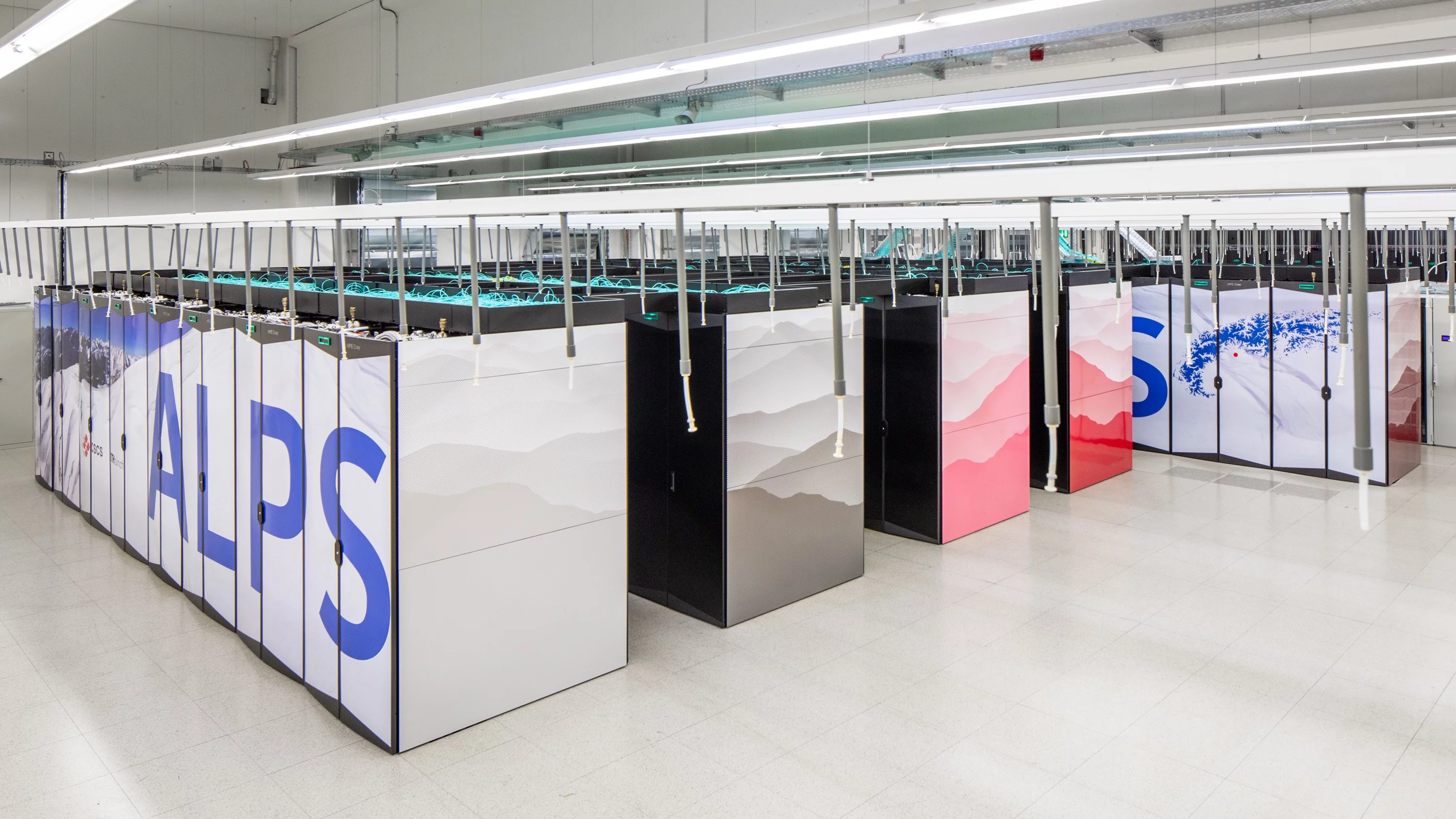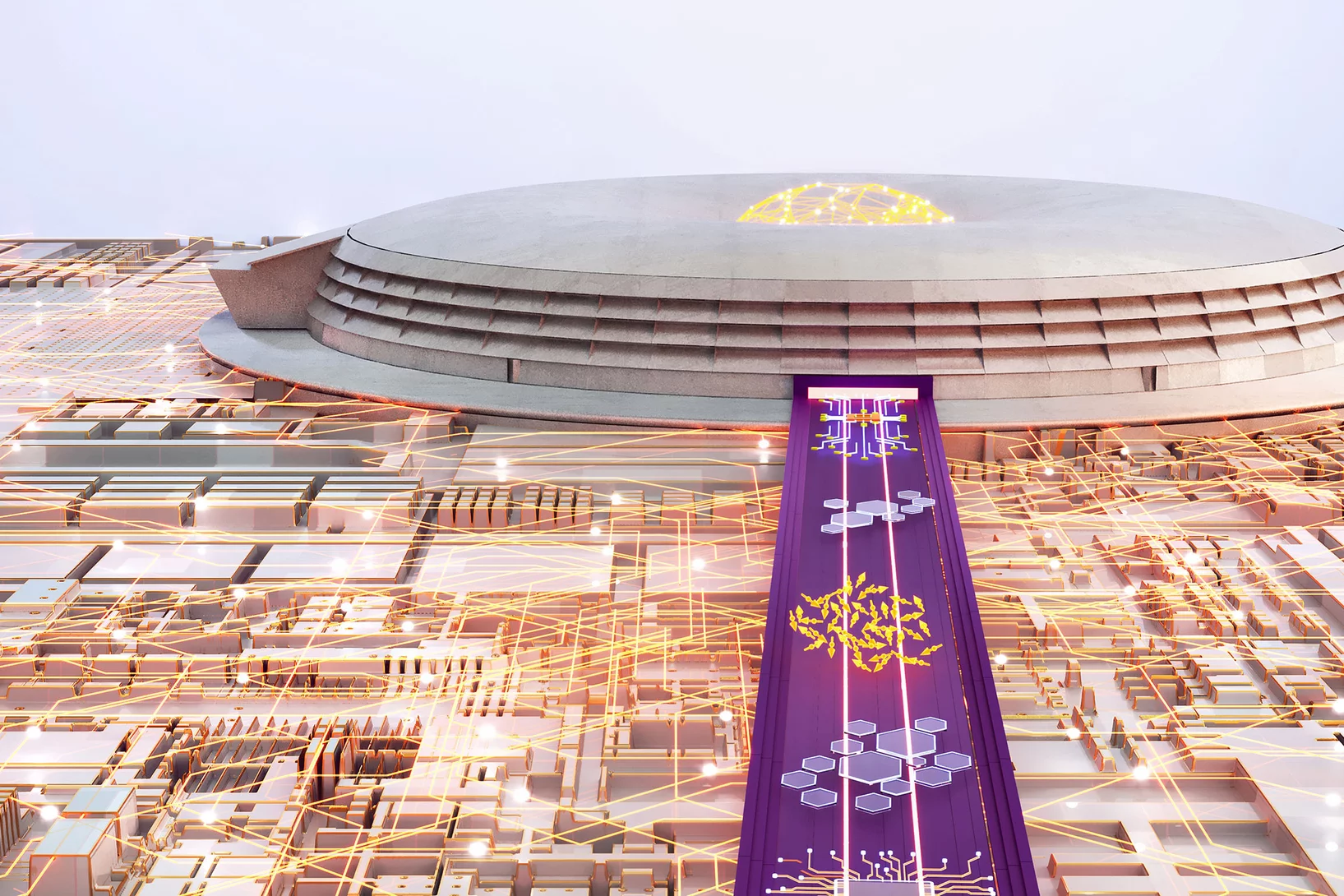The Paul Scherrer Institute PSI is getting a new high-performance computing cluster: Merlin-7 – a platform for sophisticated simulations and data analyses. Merlin-7 is not located at PSI in Villigen, however, but at the Swiss National Supercomputing Centre (CSCS) in Lugano. It is part of Alps, currently the eighth-fastest supercomputer in the world. With this, PSI and CSCS are launching a new era of computer-based science in Switzerland.
In all of its research disciplines, PSI is at the forefront internationally. This is thanks in no small part to a series of powerful computing clusters – Merlin-1 to Merlin-6 – that have formed the backbone of data-intensive research for more than two decades. Each of these clusters was many times faster than its predecessor. They all had one thing in common, though: their hardware was always located in PSI's in-house computing centre.
With its latest upgrade, PSI is breaking with this tradition. Merlin-7 is not located on campus, but at the Swiss National Computing Centre (CSCS) in the Cornaredo district of Lugano. Even this description, however, is not entirely accurate: Merlin-7 is not a standalone computing machine. Within CSCS, it is part of a much larger computing unit – the national supercomputer called Alps with its 14,000 processors.
Now that they use Merlin-7 for their work, PSI researchers no longer access a physical machine in a cabinet bearing the PSI logo. Instead, Merlin-7 resides on a virtual “island” that uses a dedicated share of the enormous computing power of Alps, giving them a level of performance appropriate to their needs. Their experience of using the system mostly feels like any of the previous in-house systems – it is seamlessly integrated into the PSI network and services – despite its being located on the other side of the Alps.
CSCS's new flagship computer currently ranks eighth in the top 500 list of the fastest supercomputers. Only seven supercomputers in research labs in the USA (4), Germany, Italy, and Japan are currently faster. Alps is based on the "Cray EX" architecture of the US manufacturer HPE. It is packed with around 14,000 processors, 10,752 of which are from NVIDIA, the others from AMD. Alps achieves 434.9 petaflops (quadrillion computing operations per second). The system is cooled with water pumped from a depth of 45 metres in Lake Lugano – 460 litres per second. This makes Alps one of the most energy-efficient supercomputers in the world. And one of the least expensive. Due to supply bottlenecks, NVIDIA chips now cost twice the price CSCS and NVIDIA agreed to when the order was placed three years ago.
More flexible, more economical, and faster
The switch from the in-house data centre to the shared high-performance cluster offers many advantages – above all, greater flexibility in regard to computing capacity. For particularly intensive computational tasks, PSI researchers can access more power on short notice. This means that Alps is not just a faster computer, but the beginning of a new era with a central, unified infrastructure for high-performance computing in Switzerland. “With the cloud-inspired architecture of Alps, we can create virtual computer clusters and tailor them to the specific needs of user communities,” explains Thomas Schulthess, director of the CSCS.
In addition to this flexibility of usage, the cluster system also scores points for its high efficiency. Relative to its computing power, Alps consumes significantly less energy than most other supercomputers in its class. This is due, on the one hand, to the energy-efficient hardware installed. On the other hand, it's because the system is cooled naturally – with water from the depths of Lake Lugano.
Thanks to its state-of-the-art hardware, Alps offers numerous new and specialised application possibilities. Alun Ashton, head of Science IT, Infrastructure and Services at PSI, emphasises: “Thanks to its Grace Hopper microprocessors from NVIDIA, Alps is ideally suited for artificial intelligence applications, which are already being used in many projects at PSI today – for example, in the analysis of protein dynamics and protein design.”
Proximity in spite of distance – thanks to optical fibres
Despite the move away from the PSI site, the user experience for most researchers at PSI remains virtually unchanged. “Nothing will change for our users,” Ashton promises. “Thanks to two fibre-optic lines, each with a data transfer rate of 100 gigabits per second, it feels to our employees as if Merlin-7 is not in Lugano, but – as before – a stone's throw away from their offices.”
While CSCS provides the fundamental IT services as part of Infrastructure as a Service – that is, a centrally available infrastructure that can be used without local hardware – Alun Ashton’s team is responsible for the complete operation of the virtual cluster platform. This includes configuring the operating system, providing scientific software, managing storage, and operating the system for the approximately 90 research groups at PSI that use it. This makes PSI the first so-called tenant to use the computing resources of Alps as “infrastructure as a service”: The portion of the Alps infrastructure provided for PSI is entirely operated and managed by PSI itself.
Alps – and thus also Merlin-7 – entered test operation in 2021 and has been in regular operation, in its final expansion stage, since January 2025. Another tenant is Meteo Swiss, the Federal Office of Meteorology and Climatology, which carries out its precise weather forecasting on Alps and might adopt a similar usage model as the one developed by PSI and CSCS in the future. The universities of the ETH Domain and CERN, too, already benefit from the computing resources at CSCS, as do many other research teams from Swiss Universities.
Proof of performance – the hero run
The power Alps packs under the hood was demonstrated impressively in August 2024 during a so-called “hero run”. A single research group at PSI was able to utilise the full power of the supercomputer during a 20-hour computing task.
Giovanni Pizzi of the Materials Software and Data Laboratory in the Center for Scientific Computing, Theory and Data, together with laboratory director Nicola Marzari, performed nearly 100,000 individual calculations, simulating thousands of material structures in parallel. This enabled the researchers to determine the properties of roughly 20,000 crystal structures. “The performance of the new Alps supercomputer is outstanding,” says Pizzi. The successful run demonstrates the versatility and capacity of Alps – particularly for tackling complex, data-intensive tasks in fields such as materials science, particle physics, and AI research.
Now it's time to put Merlin-7 through its paces. If all goes according to plan, its predecessors, Merlin-5 and Merlin-6, will be shut down over the course of the year. From that point on, PSI research will ultimately be conducted beyond the Alps – in the sunniest part of Switzerland.
Contact
More articles on this topic
About PSI
The Paul Scherrer Institute PSI develops, builds and operates large, complex research facilities and makes them available to the national and international research community. The institute's own key research priorities are in the fields of future technologies, energy and climate, health innovation and fundamentals of nature. PSI is committed to the training of future generations. Therefore about one quarter of our staff are post-docs, post-graduates or apprentices. Altogether PSI employs 2300 people, thus being the largest research institute in Switzerland. The annual budget amounts to approximately CHF 450 million. PSI is part of the ETH Domain, with the other members being the two Swiss Federal Institutes of Technology, ETH Zurich and EPFL Lausanne, as well as Eawag (Swiss Federal Institute of Aquatic Science and Technology), Empa (Swiss Federal Laboratories for Materials Science and Technology) and WSL (Swiss Federal Institute for Forest, Snow and Landscape Research). (Last updated in June 2025)





